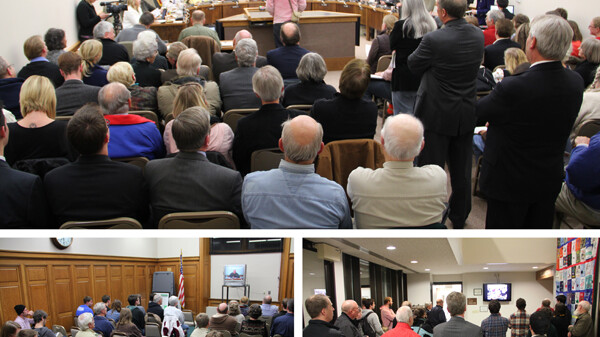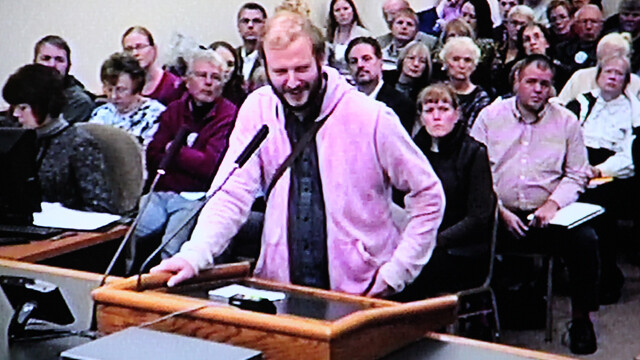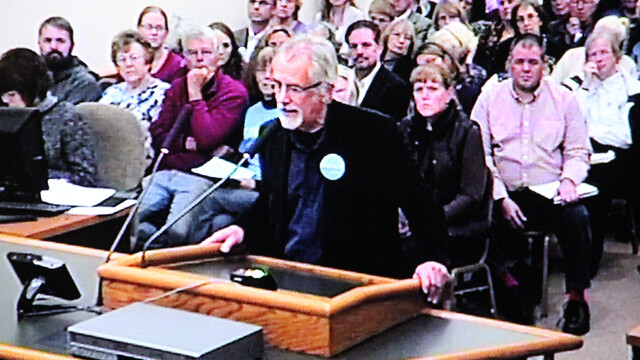Supporters, opponents come together for marathon Confluence funding debate
Tom Giffey, photos by Nick Meyer |

Dozens of speakers – from college students to corporate CEOs, from a Grammy-winning musician to our state's poet laureate – told the Eau Claire City Council Monday night what they liked (and didn’t like) about the proposed Confluence Project that could transform downtown Eau Claire. The public hearing on whether the city should pledge $5 million toward the performing arts center portion of the multi-use, public-private project went on for well over three hours, and was followed by a shorter public input session about whether the city should hold a referendum to measure voter support for the Confluence. Residents packed the council chamber to its 105-person capacity, and at least 60 others watched the proceedings on TV in the City Hall lobby and a conference room.
The resolution under consideration by the council puts a number of conditions on the city’s $5 million pledge, including $25 million in funding from the state and $20 million from private donors, a guarantee of $21.5 million value for the mixed-use building, and the establishment of a sustainable revenue stream and a governance structure for the arts center.
The City Council will hold a legislative session at 4pm today (Tuesday, Oct. 22) to vote on whether to make the $5 million pledge; the council will also debate the possibility of a referendum. The roughly $80 million Confluence Project, unveiled last year, is a joint effort by UW-Eau Claire, the Eau Claire Regional Arts Council, and Commonweal Development to build a multi-stage performing arts venue and a mixed use building (which would include commercial space and a privately-operated student dorm) on South Barstow Street.
Residents in favor of the project spoke about its potential benefits to the economy through boosting the tax base and creating jobs, improving the downtown, and stimulating the Chippewa Valley’s burgeoning arts scene. Opponents and skeptics questioned the planned demolition of century-old buildings – including one recently designated a local landmark – as well as the financial impact the arts center could have on taxpayers.
“There is the phrase ‘carpe diem’ – seize the day,” supporter Brian Larson, a retired architect, told the council. “I believe we have the opportunity to seize the day and move forward with this project.” Larson pointed to the success of Phoenix Park, just across the river from the proposed arts center, as an example of the rebirth of downtown Eau Claire.
Darin McFadden, president of the Eau Claire Area Chamber of Commerce board of directors, told the council his organization had endorsed the project because it will increase the “economic and social vibrancy” of the downtown. The project will boost property values and help mesh the strengths of the university with those of the community, he added.
The resolution under consideration by the council puts a number of conditions on the city’s $5 million pledge, including $25 million in funding from the state and $20 million from private donors, a guarantee of $21.5 million value for the mixed-use building, and the establishment of a sustainable revenue stream and a governance structure for the arts center.

Eau Claire native Justin Vernon, frontman of indie bands Bon Iver and Volcano Choir, said the Confluence Project “is a tremendous opportunity for our community to lead.”
“I think its time to take a risk,” he added. “And taking risks is something artists know a lot about.” Fostering the arts in the community can be an inspiration to everyone, from business owners to children, he said: “Creative energy is not just something for somebody who plays guitar.”
Vernon said he’s played in scores of venues around the national and world, some of them successful and others unsuccessful. Those that thrive have community involvement and good programming staffs that put the right performers in front of the right audiences, Vernon said. In addition, he said, a state-of-the art venue to replace the aging State Theatre would put Eau Claire on the map for more touring artists. “We haven’t had success putting national and international acts here because we haven’t had anywhere to put them,” he said.
Others raised concerns about the viability of the proposal, among them Maryjo Cohen, CEO of National Presto Industries and an officer of several local charitable entities, including the L.E. Phillips Family Foundation. Chief among Cohen’s objections is that this project – unlike other fundraising campaigns by local arts groups that her family’s charities have donated to – isn’t relying only on private donations. “Instead, it is being funded in an involuntary fashion” via taxpayers, she said.
Cohen noted that many performing arts centers operate at a loss that must be filled by private donors; in the case of the Confluence Center, the taxpayers may have to make up for such a shortfall, she said. In particular, Cohen pointed to a recently built (and money-losing) arts center in Burnsville, Minn., which is operated by VenuWorks, the firm that conducted a feasibility study for the Confluence Project.
Other critics focused on the proposed demolition of 19th- and early 20th-century structures to make way for the project. “Where’s your pride in preserving the history of Eau Claire?” resident Jon Case asked the council. Too much of the city’s history has already been lost to the wrecking ball, he said. “Eau Claire is not a large city and heaven forbid we should ever become one, he added.
Another Eau Claire resident, Dorothy Westermann, said the community already offers many opportunities for performing arts. “I don’t think that we need another building to house these things,” she said. Westermann said historic buildings shouldn’t be destroyed for the project and expressed concern about where patrons would park if the center is built downtown. If a joint community-university arts center is truly needed, it would be better to locate it on Water Street across from the existing Haas Fine Arts Center.

Wisconsin poet laureate Max Garland
However, supporters emphasized that the city would be getting a lot for its investment. Dan Clumpner of Commonweal Development, the private developer attached to the project, said the mixed-use building that will be part of the project will pay taxes based on $25 million of property valuation. The additional taxes paid on the property will fund the city’s share of the project’s cost via a special taxing district. Clumpner also noted that the city is poised to pledge just $5 million of the $50 million cost of the arts center. (The rest would be paid by the university, the council, and private donors.) “Have we been at this so longer that we lose sight of the fact we’re getting all of this for 10 percent of the total cast?” Clumpner asked.
Zach Halmstad, co-founder of JAMF Software and a UWEC alumnus, said the possibility of the Confluence Center prompted his firm to invest $10 million in a new office in the nearby Phoenix Park neighborhood. Efforts like the Confluence Center are key to attracting the young, talented people who work as businesses like his, Halmstad said. He also noted that the resolution the City Council is considering is a pledge to contribute money only if a host of conditions are met, including a large commitment of financial support from the university and private donors. “You guys aren’t writing a check,” he told the council. “I think that’s lost on some of us sitting here.”
Meanwhile, state poet laureate and UWEC professor Max Garland said the Confluence Center could help Eau Claire catch up to other Wisconsin communities that are participating more fully in the creativity-driven economy. “We are behind a lot of places in this,” Garland said. “The longer it takes us to get things underway, the happier the operators of other arts centers in the state are.”




















